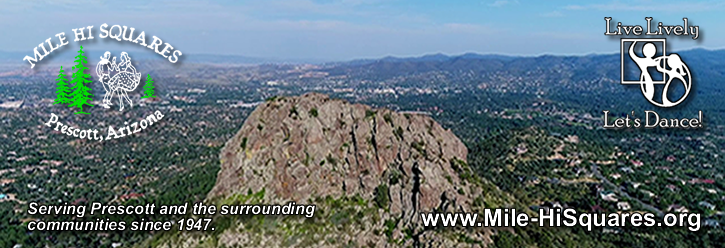The origins of Square Dancing in Prescott go back almost to the city’s beginnings. The initial formal group was called the “Post Card Squares” and consisted of 16 couples or 4 squares. The name was changed in 1947 to the “Hoedowners.” In 1948, they began performing on the Prescott Court House Square to live music. In 1949, the club became the “Mile High Hoedowners” and established their annual “Spring Fling Jamboree”. Their activities became so well known that in 1950 the square dancers traveled to Skull Valley for the making of the movie “Santa Fe”, staring Randolph Scott and Janis Carter. Skull Valley became "Dodge City" and square dancing was part of the big celebration of the building of the railroad to Dodge City. The club was paid $500.00 for their participation in the making of the movie.
A second club was started in 1952, calling itself the “Whipple Square Dance Club” and then the “Whiffle Tree Square Dance Club".
In 1970, the two clubs joined together to become what is now known as the ‘Mile-Hi Square Dance Club, Inc., a non-profit organization, which was incorporated in 1999. In 2020, the Mile-Hi Square Dance Club celebrated it's 75h year. On May 31st, 2020, Mile-Hi Square Dance Club, Inc merged with the Cottonwood Roadrunners Square and Round Dance Club, Inc becoming Mile-Hi Square Dance Club Inc, a 501(c)(3) organization.
Square Dance History...
Square dance is an American institution. It has been our "official national folk dance" since President Reagan signed an act of Congress in 1982. Square dance is a folk dance with four couples (eight dancers) arranged in a square and initially done to live music. The square dance movements are based on the steps and figures used in traditional folk dances and social dances of the various people who migrated to the USA.
The dances done in early America did not have a “caller,” or someone who yells out the moves to dancers, like square dancing today. Without the announcing systems of today, in each group, there would be at least one extrovert, the hail-fellow-well-met, the life-of-the-party type, with a knack for remembering the dance figures. With typical Yankee ingenuity, the settlers let this person cue or prompted dancers in case they happened to forget what came next.
Late in the 19th century square dancing was replaced by couple’s dances like waltzes and polkas in city ballrooms. But square dancing still thrived in rural areas. In the early 1920’s, Henry Ford became interested in the revival of square dancing as a part of his early New England restoration project. He promoted it among his factory workers and their families. Mr. Ford sponsored square dance programs in many schools. Square dancing was also brought to numerous college and university campuses at Mr. Ford's expense. He thought having square dancing in schools helped children learn manners, exercise, values and grace. Ford sponsored a Sunday radio program that was broadcast nationwide.
Square dancing expanded, especially in the decade following WWII. Many American GI's had been introduced to square dancing at USO cantinas. After the war ended, large numbers of them turned to square dancing in pursuit of a wholesome recreational activity.
Around the 1950's modern square dancing was standardized. Lessons, which are still taught today, comprise of standard moves and routines. When the Western attire of slacks and petticoats became the norm, it was considered casual compared to the formal tuxedoes and ballroom gowns of the time. Today dancing attire is even more casual with men often wearing jeans and women prairie skirts.
Today, there are thousands of square dance clubs located in nearly every community of America. Visiting other clubs has become a major aspect. Square dancing is an excellent example of an authentic American folk custom. Its rural origins are vague, and its development and diffusion are difficult to trace. Square dancing remains a solid and enduring piece of American folk tradition.
As dancers themselves are fond of saying, "Square Dancing is Friendship Set to Music." Square dancing is done in many countries around the world, but where ever it is held, the calls are always in English!
|
![]() Proud member of: Grand Canyon Square Dance Association
Proud member of: Grand Canyon Square Dance Association
![]() Proud member of: Grand Canyon Square Dance Association
Proud member of: Grand Canyon Square Dance Association